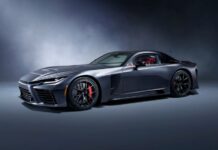The car market is becoming increasingly competitive, with car manufacturers constantly introducing new technologies to showcase their dominance, including headlight technology. From simple acetylene bulbs in the 1980s to today’s complex LED and laser technologies, it has been a long journey of development.
There are many different headlight technologies available, but there are generally 4 main types that are widely used today: Halogen, HID, LED, and Laser. Most users believe that the newer the technology, the better, meaning that Laser is the best type of headlight currently available. However, according to Autoevolution, each type has its own advantages and disadvantages, and there is no perfect type.
1. Halogen
.jpg)
Halogen bulbs are the most common type of headlight technology in the automotive industry today, due to their simplicity and low cost. On average, a halogen bulb has a lifespan of 1,000 hours under normal lighting conditions, and the cost of replacement is around $30 for a set. However, halogen is becoming a second choice for car manufacturers for a few reasons.
Firstly, halogen bulbs are made of high-temperature resistant glass, with a tungsten filament inside and argon and nitrogen gas. The filament receives energy from the battery, heating up to around 2,500 degrees Celsius and producing light.
Over time, the high temperature causes the tungsten to evaporate and deposit on the glass, creating a hole and disabling the function. However, that is only a minor issue. The most significant reason is that halogen headlights generate a large amount of heat, resulting in high energy consumption. Additionally, during maintenance and bulb replacement, if the technician is not careful, they can dirty the light reflection layer, leading to reduced brightness.
2. HID
.jpg)
Xenon headlights, also known as High-Intensity Discharge (HID) headlights, are considered to be more efficient than halogen headlights mainly due to the color temperature and light output.
HID headlights were first used in the BMW 7 Series in 1991 and gradually became a trend in cars as an optional feature. The basic operating principle of xenon headlights is similar to fluorescent lamps, consisting of two electrodes and a quartz glass tube containing xenon gas. The electric current passes between the two electrodes, providing continuous energy to illuminate the arc.
Compared to halogen bulbs, HID headlights have the advantage of being brighter and more durable, with an average lifespan of 2,000 hours. The color temperature of the bulbs is around 4,300 Kelvin, which is closer to daylight.
However, there are also many disadvantages. Firstly, HID headlights require higher usage and maintenance costs. Secondly, they take a few seconds to reach their optimal brightness because it takes time to provide energy to the electrodes and stabilize the arc. Additionally, some bulbs use harmful substances such as mercury. Finally, the high brightness of HID headlights can hinder oncoming drivers and increase the risk of accidents.
3. LED
.jpg)
As the automotive industry evolves, so do the supporting technologies. LED headlights are a testament to this, as they operate on a completely different principle than halogen or xenon headlights.
LED stands for Light-Emitting Diode. The structure and light emission of LED headlights are quite complex. In general, LEDs are based on semiconductor technology, where the movement of electrons produces radiation of various colors depending on the material in the semiconductor chip.
The first time LED headlights were used in cars was on the Audi R8 in 2004. With their compact size, LED headlights are an ideal choice for creating various shapes for the headlight strip.
One of the main advantages of LED headlights is their low power consumption. However, LED headlights can increase the temperature of the semiconductor chips, potentially causing adjacent parts and connecting cables to melt. Therefore, LED headlights always require a cooling system and are placed in the engine compartment, inadvertently impacting the functionality of other components. This is why cars with LED headlights are always more expensive due to the additional design costs.
4. Laser
.jpg)
German car manufacturers BMW and Audi are trying to bring laser headlight technology to a wide range of commercial models, believing that it is 1,000 times better than LED headlights while being similar in size.
Lasers are renowned for their dangers as they can burn anything that passes through their path. So, can lasers be used for headlights? The answer is yes, because lasers are only used for part of the light generation process.
As BMW explains, they use three blue laser beams at the rear of the headlight assembly. These beams are directed towards tiny mirrors to focus the energy onto a small lens containing yellow phosphor. This phosphor comes into contact with the laser beams and produces bright white light that is then reflected forward. Therefore, the light that viewers see is the light from the phosphor, not the laser beams themselves.
This light is 1,000 times brighter than LED headlights, has double the range, and uses only about half or two-thirds of the energy. The light produced by the phosphor has a color temperature of around 5,500-6,000 Kelvin, which is very close to the 6,500 Kelvin of sunlight.
However, the disadvantages of laser headlights are that they are very expensive, still cannot be used for both high and low beam purposes, and still require a HID or LED system in parallel. Finally, they still need a cooling system as the heat generated is even higher than that of LED headlights.
Source: Đức Huy (VnExpress)






































![[QUICK REVIEW] Toyota Yaris Cross is coming to Vietnam: Putting pressure on Kia Seltos, Hyundai Creta](https://vnauto.net/wp-content/uploads/2023/10/xehay-toyotayariscross-14062023-4-100x70.jpg)
